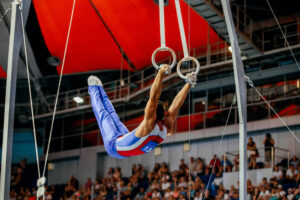Gymnastics and Injury Prevention Exercises
Gymnastics

Gymnastics require total body balance, flexibility, agility, strength, power, and endurance. Nearly all routines require the arms as its main source of performance. Therefore, it is of foremost importance to have shoulder strength, flexibility, and power with any gymnastic movement.
Supraphysiologic loads are routinely subjected by the shoulders during any gymnastic maneuver. The loads are not just simply body weight bearing forces; but because of accelerating body movements, the effective force can be multiplied by three times body weight.
Nearly 30% of all competitive gymnasts have suffered shoulder ailments at one time or another, and in almost 30% of these have had such degree of impairment or needed surgery that they were never able to achieve national or international level of competition.
Functional Anatomy
The rotator cuff muscles play a preeminent role in shoulder function and injury prevention. This group of four muscles assist the large power muscles around the shoulder in directional movements, such as raising or rotating the arm in one direction or another. However, the major function of the rotator cuff muscles is to engage the top of the arm bone (the humeral head) to tightly abut against the shoulder blade bone (the glenoid) so that these two bones are continuously compressed against each other throughout any arm motion, in any direction. This abutment of the two bones together is termed “glenohumeral joint compression”. The shoulder joint is centered and remain stable when this compressive effect is maintained. When the load on the shoulder exceeds this compressive force, either due to rotator cuff weakness or lack of control, the shoulder joint shifts (micro-subluxations) during motion and suffer injuries ranging from tendonitis to ligament/ tendon tears, or even frank dislocation.
Injury Prevention Exercise
Aside from a direct fall on the shoulder, virtually all shoulder injuries in gymnasts can be mitigated by having strong and responsive rotator cuff muscles. Therefore, it behooves all gymnasts must be disciplined with rotator cuff conditioning exercises. Pulling rubber bands or lifting dumbbells strengthen the directional movement part of the rotator cuff function; but, unfortunately, do not specifically train nor strengthen the main function of providing glenohumeral joint compression .
ShoulderSphere technique of tight and fast rotational movements effectively convert these tight rotational movements into a shoulder joint compression force. Because the user has to smoothly spin the internal ball at a fast pace, this effectively trains the necessary coordination and responsiveness of the four rotator cuff muscles to work together as one functional unit to synergistically contract to maintain a compressed, centered, and stable shoulder joint.
ShoulderSphere Program
As seen in the accompanying video, this is one of many movement patterns using ShoulderSphere.
(1) It is necessary to train both shoulders for obvious reason that all gymnastics maneuvers require both shoulders to execute.
(2) Using the larger A7, with fast spin rate to get the Power Tracker staying continuously in red for at least 5 seconds while moving the arm in one full direction of arm movement is equivalent to approximately 10 lb (4.5 kg) of rotator cuff force. 10 repetitions equate total of ~100 lb (45 kg). As an eExample — to adequately prepare body weight load supported by both arms for a 160 lb (72kg) gymnast would be eight repetitions in each arm. This is a rough approximation as a guide only. A good exercise routine for elite gymnasts should be probably at least 10 repetitions, 3 sets , for each arm.
(3) As seen in the video, it is most effective to train the rotator cuff muscles by moving the arm in all planes of motion so as to cover all the possible movement patterns during gymnastic maneuvers. This trains the responsiveness of the rotator cuff muscles to stay engaged as the arm changes directionality.
(4) Be creative with movement patterns. Disciplined program 2-3 times per week is one sure way to mitigate shoulder injury.